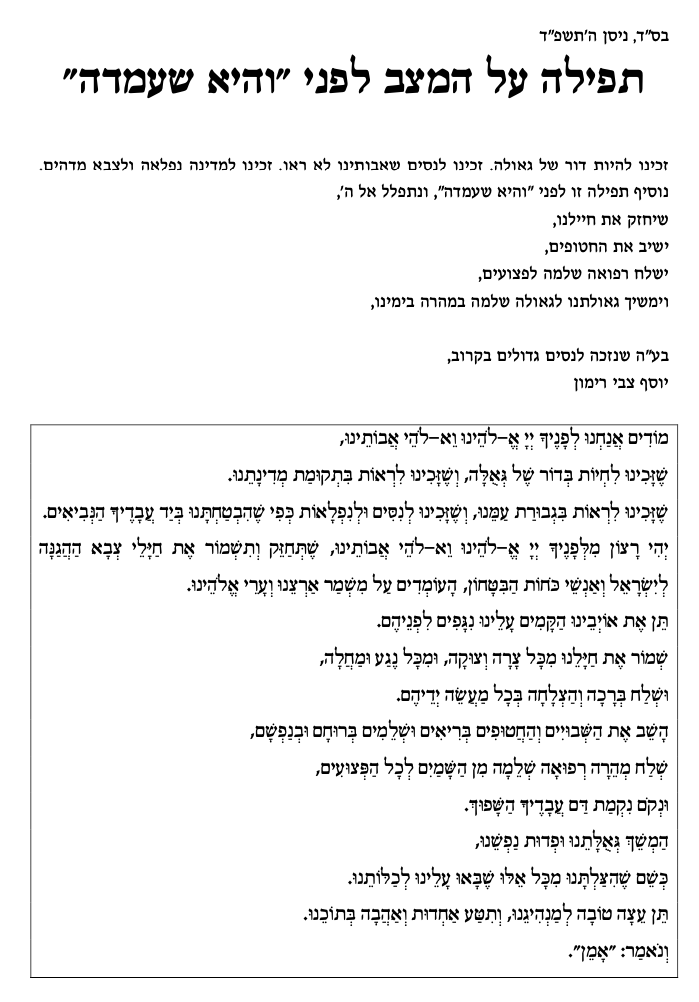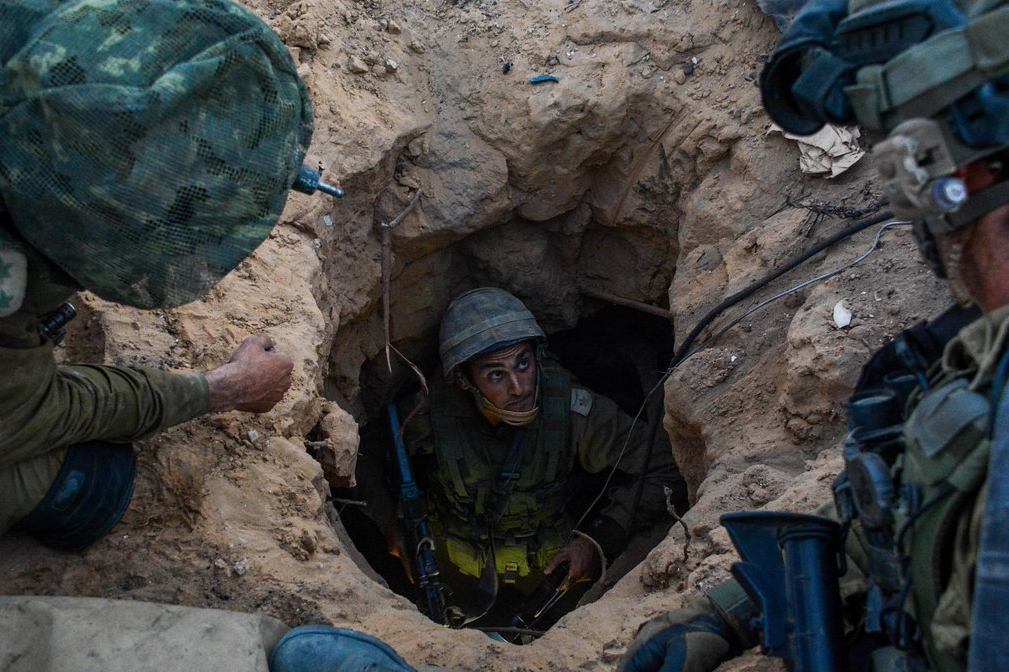It’s remarkable how, since its compilation during the time of the Mishna, the text of the Haggada has remained largely intact throughout Jewish history. While some additional poems were introduced in the 1500s, they are typically sung with great enthusiasm at the conclusion of the Seder.
Pesach is a celebration of joy, a time imbued with happiness. It serves as a commemoration not only of the miraculous redemption from ancient Egypt but as an annual opportunity for us to relive that experience. How? By cultivating a profound sense of belief and anticipation that, just as in the past, Hashem will redeem us—perhaps even today.
It’s quite a challenge to attend a Seder and expect to suddenly grasp this feeling solely through reading the Haggada. Even with the inclusion of the symbolic elements of the night—Pesach, Matzo, Marror and more—while they may enhance the educational aspect of the evening, they alone, in my opinion, won’t likely suffice. It’s no wonder, then, that educators have tried to introduce new activities into the Seder, albeit perhaps mistakenly believing that these will solve the issue
I’ve heard of individuals who carry a brick during the Seder to symbolize the experience of servitude endured by our ancestors! Others have placed an orange on the Seder plate to signal inclusivity. The proponents of deviating from the traditional Mesora are often found within the Reform/Liberal communities. With their approach of fluidity, mostly at the expense of the Masoretic tradition, one can only speculate what innovations might emerge at the Seder each year. For instance, an old schoolmate of mine (who is Orthodox) mentioned planning to include olive branches at his Seder to emphasise messages of peace amidst a diverse group of guests. (I advised him against altering the Seder Plate or the Haggada and suggested integrating the branches into discussions relevant to specific sections of the Haggada text.)
I believe the motive behind these additions is well-intentioned but often stems from a lack of comprehensive Jewish knowledge. How much effort is put into studying the various texts of the Haggada before the Seder? With a growing abundance of Haggadas published annually, each with its own unique style and approach, it seems that in many cases, there is little to no preparation. While those who lead a traditional Seder without the allure of a ‘Seder Getaway’ to an exotic location may indeed find themselves exhausted—some more than others—the Seder and the Haggada benefit from a year-round regimen of Jewish learning. Engaging with Torah study, even if it’s just an hour a week, can significantly deepen one’s understanding of the text and bring them closer to the assurance that God has promised to redeem us swiftly in our time.
The disparity between those who can more readily experience the joy of Pesach and those facing greater challenges is accentuated during times of hardship. How can we cultivate happiness amidst suffering? How do we overcome feelings of despair?
Irving J. Rosenbaum wrote:
“Observance of Passover, the “Festival of Freedom,” by the Jews enslaved in the ghettos and concentration camps of Nazi Europe would appear, at first glance, to be anomalous, if not actually blasphemous. Yet upon reflection it becomes evident that this was the festival in the Jewish religious calendar which spoke most directly to their condition. The familiar phrases of the Haggadah took on new and immediate significance.
This is the bread of affliction… now we are slaves—next year we shall be free men. … and also that nation whom they shall serve, will I judge; and afterward they shall come out with great substance.
This is the bread of affliction… now we are slaves—next year we shall be free men. … and also that nation whom they shall serve, will I judge; and afterward they shall come out with great substance. It is this divine pledge that hath stood by our fathers and by us also. Not only one hath risen against us to destroy us, but in every generation have men risen against us to destroy us-but the Holy One, blessed be He, delivereth us always from their hand… Pour out thy wrath upon the nations that have not known thee, and upon the kingdoms that have not called upon thy name: for they have devoured Jacob and laid waste his dwelling place… Pour out thy indignation upon them, and let thy wrathful anger pursue them. Pursue and destroy them in anger from under the Heavens of God
“The Holocaust and Halacha” by Irving J. Rosenbaum, Ktav 1976
After the Holocaust, there was indeed a push to integrate the tragedy of the Holocaust into the Passover Seder. However, this idea was vehemently rejected by Rabbi Yosef Dov Halevi Soloveitchik, known as the Rav. In a letter to Rabbi Theodore Adams in 1953, the Rav expressed (my emphasis below):
As to the suggested addition to the Seder service in the form of a memorial for our brethren lost in the Nazi Holocaust, I strongly disapprove both of the idea itself and of the text.
Jewish tradition has introduced a separate memorial service for the deceased on the three pilgrim festivals and on Yom Kippur, which in its initial phase was probably confined to the commemoration of those who incurred a martyr’s death. (It apparently came into existence in the period following the Crusades. The recital of the Av ha-Rahamim prayer as a continuation of the memorial service and its place in the regular Sabbath service corroborate this point). There is no reason why we should add a new memorial for the martyrs of the most recent catastrophe as a part of the Seder service, which has been dedicated to the great miracle of Jewish redemption and survival. The superhuman historical experience of Jewish martyrdom has found other media of expression and manifestation not connected with the epic of the exodus. Neither the scholars who survived the Bar Kokhba debacle nor the generation of the Crusades nor the contemporaries of the Spanish Inquisition nor those at the time of the horrible Cossack pogroms of 1648 found it necessary to mar the joyous spirit of the holy night by commemorating the sad experiences they lived through.
The Halakhah has always looked askance upon any attempt to introduce a note of sadness into the festive and joyous mood of a holiday. Even the memorial service was designated whenever possible (on Pesah and Shavuot) on the last day of the holiday (yom tov sheni shel galuyot). In my opinion, the few sentences of shefokh hamatkha, great and awe-inspiring in their simplicity, serve the purpose far better than any “synthetic” product prepared by modern rabbis and secularists. Let us instead request all congregations to say the traditional prayer of El Male Rahamim for the millions of martyrs on the last day of Passover as a part of the conventional memorial service.
Community and Covenant, Selected Letters and Communications, Edited by N. Helfgot, Ktav 2005.
This year, we face another challenge, this time due to the terrible calamity of the hostages seized by Hamas terrorists. Can we truly embrace feelings of joy at the Seder while our brothers and sisters are in severe anguish? There’s no need for elaboration. Not a single home in Israel remains untouched by direct or indirect tragedy. As the Rav wrote, ‘Shefokh Hamaskha’ certainly encapsulates our collective hope.
So, what about the Seder? Should we solely focus on the parts that recount the suffering of the Jews and resonate with that narrative? Yes, indeed, we can and should. However, the real challenge, as mentioned earlier, lies in maintaining faith that Hashem has a plan—a plan that surpasses human understanding. His plan instills joy because it promises redemption. We must hold onto this belief. It’s the underlying message that has upheld Jews and Judaism throughout history. Without it, we would have assimilated and vanished long ago. This is the essence of the joy of Pesach—the miraculous and supernatural endurance and redemption of the Jewish people.
Some have advocated a special prayer to be said before Vehi Sheamda. The Ashkenazi Chief Rabbi David Lau published a special prayer
יְהִי רָצוֹן מִלִּפְנֵי אָבִינוּ שֶׁבַּשָּׁמַיִם
אֲשֶׁר הוֹצִיא אֶת עַמּוֹ יִשְׂרָאֵל מִתַּחַת סִבְלוֹת מִצְרַיִם
הוּא יְבָרֵךְ וְיִנְצֹר אֶת אַחֵינוּ וְאַחְיוֹתֵינוּ הַחֲטוּפִים
הָאֲסוּרִים בְּכַבְלֵי בַּרְזֶל
יְחַזֵּק נַפְשָׁם וֶאֱמוּנָתָם
יִשְׁמְרֵם מִכָּל נֶגַע וּמַחֲלָה
יַחְמֹל עַל בָּנָיו וּבְנוֹתָיו הַמְּצַפִּים לִישׁוּעָתוֹ
יְבַטֵּל מֵעֲלֵיהֶם כָּל גְּזֵרוֹת אַכְזָרִיּוֹת
בְּחַסְדּוֹ הַגָּדוֹל יָחִישׁ פְּדוּתָם וְיֵצְאוּ מְהֵרָה מֵאֲפֵלָה לְאוֹרָה
וּמִבּוֹר הַשְּׁבִי לְחֵרוּת עוֹלָם
וְיָשׁוּבוּ לְשָׁלוֹם אֶל מִשְׁפְּחוֹתֵיהֶם וְאֶל בָּתֵּיהֶם
אָנָּא, נֶטַע אַחֲוָה שָׁלוֹם וְרֵעוּת בְּלֵב כֻּלָּם
הָסֵר קִנְאָה וְשִׂנְאַת חִנָּם וּפְרֹס עָלֵינוּ סֻכַּת שְׁלוֹמֶךָ
וְנִזְכֶּה בְּקָרוֹב לוֹמַר לְפָנֶיךָ שִׁירָה חֲדָשָׁה.
a loose translation of which is
May it be favourable before our Father in heaven
Who brought out His people Israel from the crushing burdens of Pharaoh’s Egypt,
That He bless and protect all our brothers and sisters who are hostages and in captivity
Incarcerated in iron chains.
May he strengthen their souls and faith,
Guard them from all distress and injury.
May He have compassion on his children who eagerly yearn for His deliverance.
May He annul every cruel decree issued against them.
In his great mercy, may He redeem them rapidly, so they go out with haste from darkness to light
From the pit of the dungeon to perpetual freedom.
And may He return them in peace to their families and homes.
Please, plant fraternity, peace and kinship in the hearts of them all.
Remove envy and causeless hatred and spread out the canopy of Your peace.
And may we merit very soon to utter before you a new song [of joy and praise]
I heard that Rav Yosef Tzvi Rimon also published a prayer though I haven’t seen it. I will update this post when I get a copy.
Some suggestions have been less than sensible. For instance, one individual apparently proposed reducing the number of matzos from three to two (as was the general practice of the Rambam and others) to symbolise the grief we are experiencing. However, in a lecture by Rabbi Shay Schachter, a compelling argument is made that those seeking to express their grief symbolically through food should refrain from altering the matzos. We adhere to our Masoretic tradition of three matzos. Instead, someone wishing to utilise food symbolism might consider (based on the Gemara) reducing the variety of appetisers, skipping dessert, or forgoing kneidlach (for those who don’t avoid Gebrokts), among other options.
In a similar vein, I heard that someone approached the Lubavitcher Rebbe and proposed keeping an empty chair to symbolise those who cannot participate in a Seder. While this suggestion may seem reasonable, the Rebbe’s response was characteristically incisive, offering a better and more consistent approach in line with what I have previously written.
“Instead of having an empty chair, have an extra chair, and invite another Jew who might not have come to the seder”
I don’t have a citation for this comment at present.
Yes, it will be challenging. Yes, we vividly feel the suffering, but the Haggada offers enough, especially if we prepare adequately, to help us recognise that the suffering will come to an end and pave the way for the promised Redemption. Simcha must be the aim of our state of mind.




You must be logged in to post a comment.